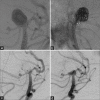Usefulness of Y-shaped PulseRider-assisted coil embolization for basilar artery tip aneurysm with a misaligned axis: A case report
- PMID: 37680930
- PMCID: PMC10481857
- DOI: 10.25259/SNI_449_2023
Usefulness of Y-shaped PulseRider-assisted coil embolization for basilar artery tip aneurysm with a misaligned axis: A case report
Abstract
Background: Endovascular treatment of wide-necked bifurcation aneurysms remains challenging. Although the advent of PulseRider and Web has expanded treatment options, aneurysms with a large deviation from the parent artery axis remains difficult to treat. We present the case of a wide-necked bifurcation aneurysm that was misaligned with the angle between the long axis of the parent artery and the aneurysm and was successfully treated with Y-shaped PulseRider-assisted coil embolization.
Case description: A 64-year-old woman presented with an unruptured basilar tip aneurysm. Cerebral angiography showed a wide-necked aneurysm measuring 8.1 mm × 6.1 mm, neck 5.7 mm. The aneurysm was strongly tilted to the right and posterior relative to the basilar artery, and the bilateral posterior cerebral artery (PCA) and superior cerebellar artery (SCA) diverged from the aneurysm body. PulseRider-assisted coil embolization was performed. A Y-shaped PulseRider was selected to be placed in a hybrid fashion with the right arch in the aneurysm and the left arch in the branch. Adequate coil embolization with preservation of the bilateral PCA and SCA was possible, and cerebral angiography immediately after the treatment showed slight dome filling. Cerebral angiography 6 months after the procedure showed that the embolic status had improved to complete occlusion.
Conclusion: For wide-neck bifurcation aneurysms with a misaligned axis, a Y-shaped PulseRider used in a hybrid fashion, in which the leaflet on the side with the tilted axis is placed in the aneurysm, allows the PulseRider to be deployed more closely to the aneurysm, thereby enabling good coil embolization.
Keywords: Coil embolization; PulseRider; Wide-neck bifurcation aneurysm.
Copyright: © 2023 Surgical Neurology International.
Conflict of interest statement
There are no conflicts of interest.
Figures



Similar articles
-
PulseRider "jack-up" technique for wide-necked basilar tip aneurysms that incorporate parent arteries: A technical note.Surg Neurol Int. 2023 Jan 13;14:9. doi: 10.25259/SNI_998_2022. eCollection 2023. Surg Neurol Int. 2023. PMID: 36751453 Free PMC article.
-
Enterprise Treatment for Recurrent Basilar Tip Aneurysm after PulseRider-assisted Coil Embolization: A Case Report.NMC Case Rep J. 2023 Apr 21;10:115-119. doi: 10.2176/jns-nmc.2022-0316. eCollection 2023. NMC Case Rep J. 2023. PMID: 37197284 Free PMC article.
-
Treatment of wide-necked basilar tip aneurysm not amenable to Y-stenting using the PulseRider device.BMJ Case Rep. 2015 Jul 21;2015:bcr2015011836. doi: 10.1136/bcr-2015-011836. BMJ Case Rep. 2015. PMID: 26199295 Free PMC article.
-
Efficacy and safety of PulseRider for treatment of wide-necked intracranial aneurysm-A systematic review and meta-analysis.Interv Neuroradiol. 2021 Feb;27(1):60-67. doi: 10.1177/1591019920940521. Epub 2020 Jul 7. Interv Neuroradiol. 2021. PMID: 32635777 Free PMC article.
-
Endovascular Treatment of Wide-Neck Bifurcation Aneurysm: Recent Trends in Coil Embolization with Adjunctive Technique.J Neuroendovasc Ther. 2024;18(3):75-83. doi: 10.5797/jnet.ra.2023-0072. Epub 2024 Jan 13. J Neuroendovasc Ther. 2024. PMID: 38559450 Free PMC article. Review.
References
-
- Blackburn SL, Kadkhodayan Y, Shekhtman E, Derdeyn CP, Cross DT, 3rd, Moran CJ. Treatment of basilar tip aneurysms with horizontal PCA to PCA stent-assisted coiling: Case series. J Neurointerv Surg. 2013;5:212–6. - PubMed
-
- Fiorella D, Albuquerque FC, Han P, McDougall CG. Preliminary experience using the Neuroform stent for the treatment of cerebral aneurysms. Neurosurgery. 2004;54:6–16. - PubMed
-
- Fiorella D, Arthur AS, Chiacchierini R, Emery E, Molyneux A, Pierot L. How safe and effective are existing treatments for wide-necked bifurcation aneurysms? Literature-based objective performance criteria for safety and effectiveness. J Neurointerv Surg. 2017;9:1197–201. - PubMed
Publication types
LinkOut - more resources
Full Text Sources
